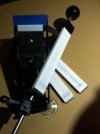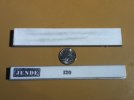Hi,
And what grit do I need to go to in order to have the knife shave leg hair?
Raise a burr with coarse 200-600 grit stone, preferably not gigantic burr, cut it off with 2-10 passes at higher angle. Thats it.
You should be able to shave after the first sharpening stone, whatever grit that happens to be.
Extra coarse like under 150 grit needs a bit more care/experience to get there.
200 grit and higher and everybody should be able to get there provided they try.
Even the burr itself should shave arm/leg hair, even a curled over burr, ouchy but shave.
Hi,
I was told to do 30 strokes at the lowest grit, then triple it for every grit I increase. For example, 30, 90, 270, etc. But this equates to thousands of strokes if you go to 10k grit like I do
Thats like something mors kochanski would say, its not true.
But thousands of strokes ain't nothing but 10 minutes

It maybe takes 30 strokes on your coarsest grit if everything goes perfect,
but a regular sharpening even from a newbie shouldn't take more than 300 strokes on coarse grit (200-400).
If its taking more than 300 strokes youre fixing damage changing angles or both.
Yes, the more stones you use, the more strokes you'll use , but that should not be surprising.
You dont have to polish the entire bevel only the last 1-20 microns and that should be fast.
Here are numbers for a tight lots of stone "stones" progression for high polish with good angle control
Sharpening Plane Blade on Granite Block
P80 (197 micron) however many strokes it takes, like 10
P120 (127 micron) 5-10 strokes completely erases the P80 scratch pattern
P180 (78 micron) 5-10 strokes
P240 (58.5 micron) 5-10 strokes
P360 (40.5 micron) 5-10 strokes
P500 (30.2 micron) 5-10 strokes
P800 (21.8 micron) 5-10 strokes
P1200 (15.3 micron) 5-10 strokes
P2000 (9.5 micron) 5-10 strokes, plus maybe 5-10 deburring
so thats 110 strokes total maybe.
This is with 3-4 stones and bigger/common grit jumps. Its more strokes but its not thousands. The bevels aren't fully mirror polished, but the apex is.
Re: Grit Progression by CliffStamp
-cut off the apex
-reshape on Suehiro 'Chemical' 320 grit (30 micron), 30seconds to 2minutes 30 seconds , 100-500 passes, depending on steel
-grind the edge on a 400 grit Naniwa Superstone (40 micron, muddy), 30seconds to 1 minute, 120-240 passes
-grind the edge on a 2000 Naniwa Aotoshi (8-9 micron muddy), 30seconds to 1 minute, 120-240 passes
-micro-bevel on 8000 , 10 seconds, 1-10 passes
So thats 300 to 1000 strokes.
Interesting way to review stones
cliffstamp.com/knives/reviews/ns400.html
cliffstamp.com/knives/reviews/suehiro_chemical_320.html
cliffstamp.com/knives/reviews/naniwa_aotoshi.html
Oh, and is there a minimum grit that should make the edge not reflect light? Or is that another "depends" thing?
Grits just sit there, you make the grits erase reflections by rubbing the knife on the grits.
This makes me think you have no abrasives, no knives, and have never tried sharpening.
Okay so maybe a dumb question again but I'm learning, but if I'm not cutting paper at 1000 grit, am I doing something wrong? What should I do differently? Could it be my stones?
What are you doing?
Its not the equipment, its how you use it.
The question "maybe dumb" because you dont seem detailed in explaining how/why/what you're doing...
ask question, try out the answer, figure out how/why the answer works, then try again,
... this loop does not include buying more stuff,
just trying and using the stuff you own to figure it out what you're doing and what you should be doing
maybe writing down stuff on paper helps you remember what you've done, why, what you should do ...



